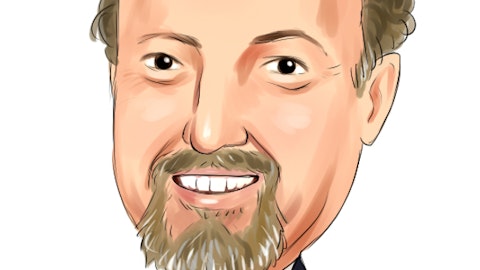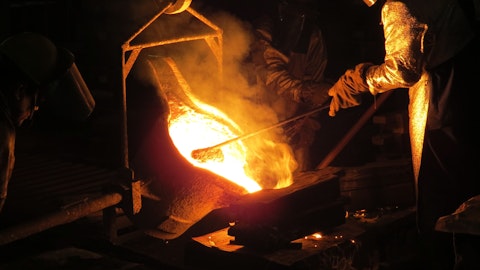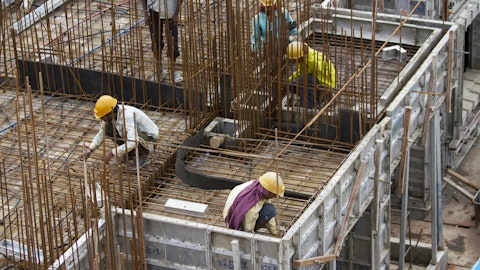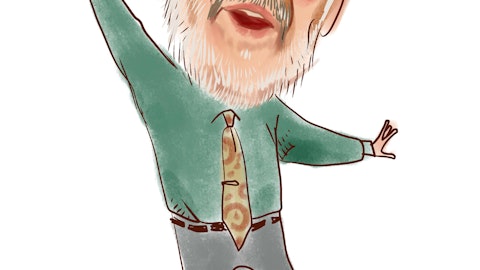That is very difficult. This year we might have imports that are greater than 20%, not because the demand is bad. We have been through worst moments in Brazil. In 2010 to 2013, [BRL25 million]. We’re in that value of 2015, 2015 in [BRL21 million. It’s not that we are at BRL13 million]. The market is not that. The problem is that with those [BRL13 million, we’re running the risk of having 2 million or 2.5 million] imports will truly hamper our performance. We need a measure. I’m now referring to protectionism, but we should have a better symmetry in terms of competition, not only when it comes to Chinese imports, but others as well. The broad majority, of course, are Chinese imports. We can’t simply sit around and watch what is happening. And CSN is very strong in the coated material.
We also have good news. The unexpected reduction of 0.5% in our interest rate with very positive results. In my opinion, of course, it’s not exceptional, but most certainly, it will help the consumer goods and construction segments, even the automotive sector, the measure imposed by the government, did help and abet this increasing sales by 27%. If somebody will pay for this later, yes, but the sales did increase. These are measures that helped at a specific point in time and with a reduction of interest rates with a gradual reduction. In the second half of the year, we should have a more stable demand in the distribution sector, in the truck sector, we have different variables. In distribution. they’re not working with high inventories. Trucks are being sold well, but less because of the €6.
Now if we look at the sector as a whole, it’s stable at [BRL13 million]. We have to be careful with the imports and with low inventories. When it comes to prices, we’re heading towards stability and depending on what happens in China. And I think this might be something unexpected. I’ve seen it happening if there’s a leap in prices of $100, depending on how strong the measures are. Perhaps we can think of a realignment of prices in Brazil. All of this will depend on how the market advances. We had margins of $500 per ton, and our margins have dropped considerably. No steel plant in Brazil can work with such low margins. We have to increase them with a cost reduction and also increasing the wealth of our portfolio, trying to recover price margins.
Now when it comes to the volumes, we are forecasting a stronger third quarter in terms of volumes. As Benjamin mentioned, there will be a cost recovery that will help us to better position ourselves in the market. We have to be more cautious, not to attack the margin and — the market and maintain our margins. Prices will have to remain stable. But with this, we can move more in areas where we have higher competitiveness with our products, especially in coated products. Now this is a situation at present in Brazil for the third quarter. Our vision going forward, I think we’re going to have the most positive quarter in the last few years because of that drop in interest rates should extend until the end of the year. Now regarding strategy and Benjamin spoke about the purchase of slabs who help in the — we have been purchasing slabs.
We’re doing very well in terms of prices. And this will put us in an interesting position of competitiveness to be able to work with important material that is already in Brazil. It’s a reality. That is the scenario that we’re considering for Brazil until the end of the year. It was some more lengthy, but I think I was able to set up a very good panorama for Brazil until the end of the year.
Marcelo Cunha Ribeiro: You made a question for Benjamin, Caio, is there any follow-up that you require after what Martinez mentioned?
Caio Greiner: No, that was very good.
Benjamin Steinbruch: Very well, Caio. Regarding your question. Nothing changes after what we have said and our commitment with the market. I can say that we do have some assumptions, some pillars that are fundamental and priorities for us: ESG and technology in the first place; secondly, deleveraging; in the third place, a sound capital structure; fourth, a more adjusted operation and adequate operating margins; and fifth, growth opportunities that we have organically and also through merchants and acquisitions. And this is the order through which we guide ourselves and this is how we work to be able to achieve the growth and development of the Company. By following these parameters, I would like to remind you that last year, we brought in the [indiscernible].



